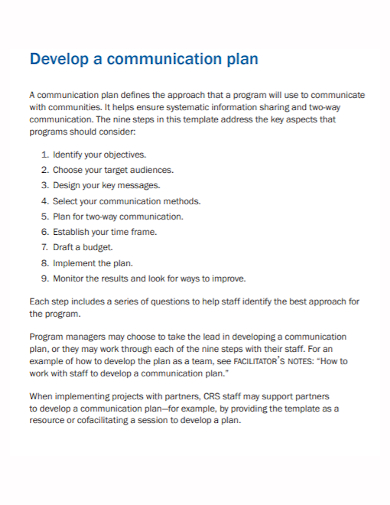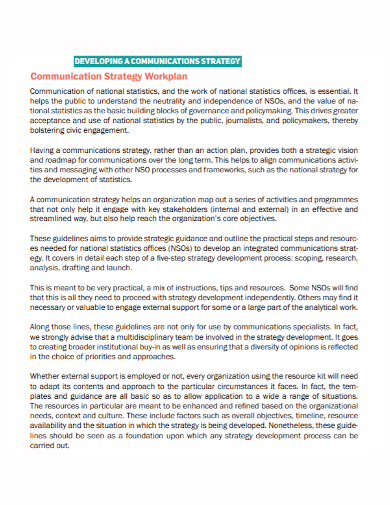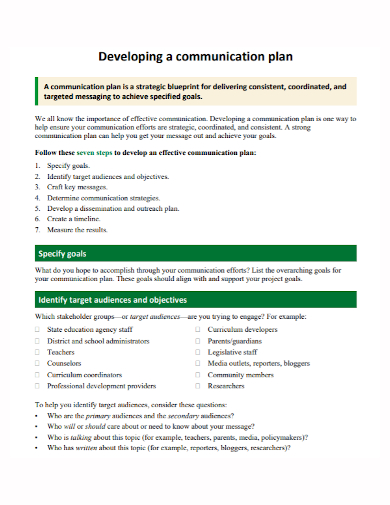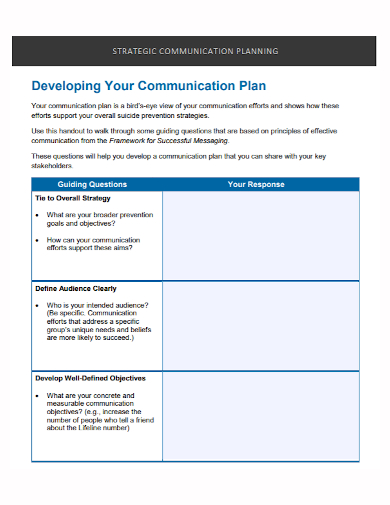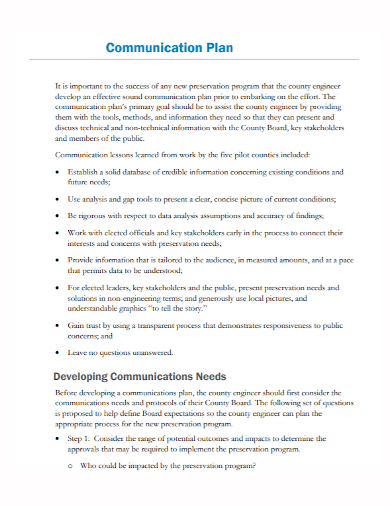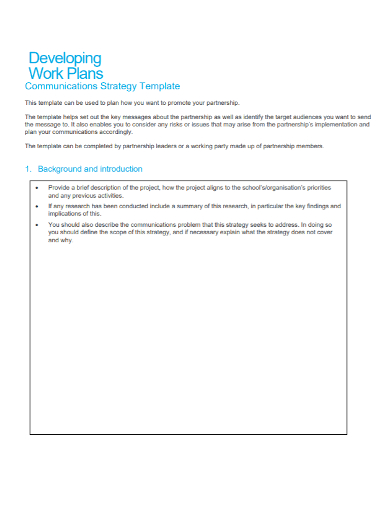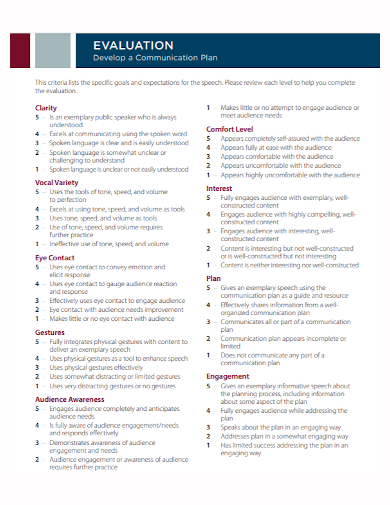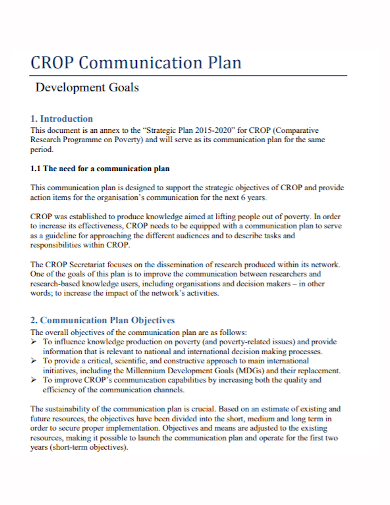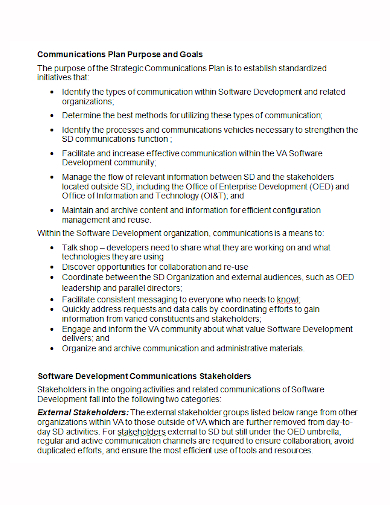A communication plan can assist you in focusing your message and reaching your target audience. Your communication methods’ efficiency and simplicity might also be influenced by a plan. This section explains what a communication strategy is, how to make one, when to use one, and how to utilize one to generate awareness about your topic or cause. The process of transmitting ideas and information is known as communication. For a grass-roots effort or community-based group, this entails informing the community about the genuine nature of your organization, the challenges it addresses, and its accomplishments. Word of mouth, news stories in print and broadcast media, press releases and press conferences, posters, brochures, and fliers, outreach and presentations to other health and community service providers, community groups, and organizations, and special events and open houses held by your organization are all examples of communication.
A communication development plan functions as a map for getting your message out to your target audience. It’s a must-have tool for ensuring that your company conveys a clear, targeted message with measurable outcomes.
10+ Communication Development Plan Samples
1. Communication Development Plan Template
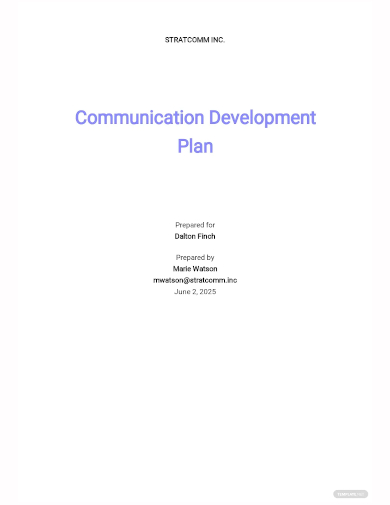
2. Software Development Communication Plan Template

3. Communication Development Plan
4. Communication Development Work Plan
5. Sample Communication Development Plan
6. Communication Development Strategic Plan
7. Communication Needs Development Plan
8. Communication Strategy Development Work Plan
9. Communication Evaluation Development Plan
10. Communication Development Goals Plan
11. Communication Software Development Plan
Developing a Plan for Communication
With a strategy in place, you’ll be able to focus your communication more precisely. It provides you with a framework for determining who you need to contact and how you should contact them. A long-term strategy can assist you to map out how to grow your visibility and improve your image in the community. Your communication efforts will be more efficient, successful, and long-lasting if you have a plan. Everything is easier when you have a plan. If you spend some time preparing before the start of a project, you will save a lot of time afterward since you will know what to do at any point during the process.
How to Develop a Communication Plan?
- Identify the purpose – What you say will be determined by the goals you’re pursuing with your communication strategy. You could be concerned about one or more of the following:
– Getting to know, or being better known in the community
– Educating the public about the subject your organization handles
– Recruiting participants or beneficiaries for your program
– Recruiting volunteers to assist with your job
– Activating supporters or the general public for your cause
– Publicizing events
– Celebrating honors or successes
– Raising funds to support your work
– Rebutting opponents’ arguments, errors, and, on rare occasions, lies or misrepresentations
– Dealing with a well-publicized organizational problem - Identify your audience – Who are you attempting to contact? Knowing your audience allows you to design your communication in a reasonable manner. You’ll need different messaging for different audiences, as well as different channels and strategies to reach them.
- The message – Consider content, mood, language, and design while crafting your message.
- Resources – Your strategy should involve detailed calculations of how much money you have to spend and how much staff and volunteer time you can use. Individuals, corporations, other organizations, and institutions may be able to exchange resources, air time, and other goods and services with you.
- Obstacles and emergencies – During the course of a communication attempt, a variety of things can happen. It is possible to forget to e-mail a press release or to include a phone number or e-mail address. It’s possible that a keyword on your posters or brochure may be misspelled, or that a reporter could get critical facts wrong. Worse, you may be forced to deal with an actual tragedy involving the company, which could jeopardize everything you do.
- Media and others to spread the message – Establishing ties with individual media representatives and media outlets, as well as key individuals and institutions in the community and the population you’re aiming to reach, is an important aspect of a communication strategy. To keep communication lines open, you must create personal contacts, provide the media and others reasons to want to help you, and follow through to maintain those ties.
- Action plan – Now it’s up to you to put it all together into a workable plan. By the time you get to this phase, you’ve already completed the majority of your strategy. You know what your goal is and who you need to reach to achieve it; you know what your message should say and how it should look; you know what you can afford; you know what problems you might face, and you know what channels to use to reach your target audience and how to get access to those channels.
- Evaluation – You’ll be able to make modifications to improve your communication plan if you analyze it in terms of both how well you carry it out and how well it performs. Each time you use it, it will become even more effective.
FAQs
When to develop a communication plan?
You should start developing ways to convey your organization’s aims and actions as soon as you start planning them; effective communication is a continuous process, not a one-time event. Communication is beneficial at every stage of your organization’s development; it can assist spread the news about a new organization, rekindle interest in an old program, or attract new funding sources.
What are the characteristics included in identifying your audience?
It includes demographics, geography, employment, health, behavior, and attitudes.
If you want to see more samples and formats, check out some communication development plan samples and templates provided in the article for your reference.
Related Posts
FREE 8+ Debt Management Plan Samples in PDF | DOC
FREE 10+ Sales Management Plan Samples in PDF | MS Word | Apple Pages | Google Docs
FREE 4+ 30-60-90-Day Marketing Plan Samples in MS Word | Google Docs | Apple Pages | PDF
FREE 10+ Higher Education Lesson Plan Samples in MS Word | Pages | Google Docs | PDF
FREE 9+ 30-Day Marketing Plan Samples in PDF | MS Word | Apple Pages | Google Docs
FREE 3+ Sales Team Action Plan Samples in PDF | MS Word | Apple Pages | Google Docs
Marketing Plan For Small Business Samples
FREE 7+ Fashion Business Plan Samples in PDF
FREE 10+ Sprint Planning Samples In MS Word | Google Docs | PDF
FREE 10+ Wedding Planning Samples in MS Word | Apple Pages | Powerpoint | PDF
FREE 9+ Monthly Study Planner Samples in PSD | Illustrator | InDesign | PDF
FREE 9+ Sample Curriculum Planning Templates in PDF | MS Word
FREE 10+ Teacher Development Plan Samples in MS Word | Google Docs | Apple Pages | PDF
FREE 10+ Basketball Practice Plan Samples in PDF
FREE 12+ School Business Plan Samples in PDF | MS Word | Apple Pages | Google Docs

